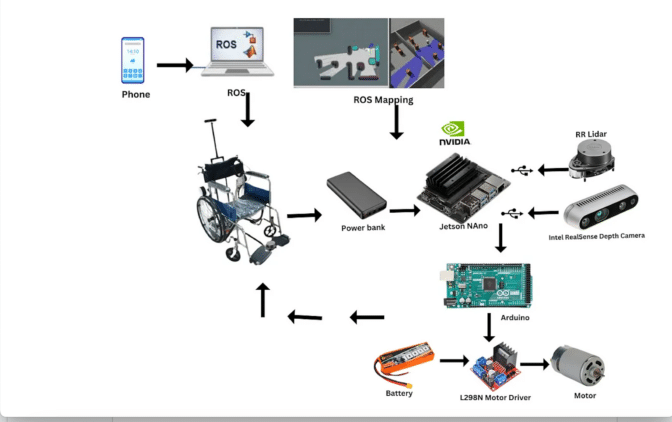TL;DR:
- Kabilan KB, a robotics student, introduces an autonomous wheelchair project.
- Utilizes NVIDIA Jetson platform for AI and robotics.
- Wheelchair equipped with depth and lidar sensors, USB cameras for environment perception.
- User-friendly interface enables easy destination input.
- NVIDIA Jetson Nano Developer Kit acts as the system’s brain.
- AI algorithms detect obstacles and plan collision-free routes.
- KB’s inspiration: addressing mobility challenges for individuals with disabilities.
- Supported by the Program in Global Surgery and Social Change.
- Future vision includes brain-controlled wheelchair navigation.
Main AI News:
In an era where AI-driven advancements are reshaping industries, Kabilan KB, an enterprising robotics student from the Karunya Institute of Technology and Sciences in Coimbatore, India, has embarked on a remarkable journey to revolutionize mobility solutions for individuals with disabilities. Leveraging cutting-edge technology, KB has introduced a groundbreaking autonomous wheelchair project, setting a new standard for accessibility and independence.
Empowering Mobility Through Innovation
Kabilan KB’s visionary project is poised to redefine the way individuals with mobility impairments navigate their surroundings. Powered by the formidable NVIDIA Jetson platform for edge AI and robotics, this autonomous motorized wheelchair is equipped with depth and lidar sensors, as well as USB cameras, enabling it to perceive its environment and chart an obstacle-free course to a user’s desired destination.
What sets this project apart is its user-friendly interface, allowing individuals to effortlessly communicate their destination to the autonomous navigation system. Users can simply input their desired location, designated by numerical values, and watch as the autonomous wheelchair expertly guides them there. Whether it’s ‘one’ for the kitchen or ‘two’ for the bedroom, KB’s innovation ensures a seamless and hassle-free journey.
The AI-Powered Brain Behind the Wheelchair
At the heart of this ingenious system lies the NVIDIA Jetson Nano Developer Kit, processing data from cameras and sensors in real time. Employing deep learning-based computer vision models, it swiftly detects obstacles in the environment. Acting as the brain of the autonomous system, it generates a 2D map of the surroundings, meticulously planning a collision-free path to the destination. This information is then relayed to the motorized wheelchair, ensuring safe and efficient navigation.
Kabilan KB’s journey into the realm of AI and robotics was sparked during the pandemic, as he immersed himself in educational YouTube content. With a background in mechanical engineering, he is now pursuing a degree in robotics and automation, driven by his aspiration to launch a robotics startup. His commitment to self-education has been reinforced through certifications from the NVIDIA Deep Learning Institute, validating his expertise in building video AI applications and developing applications in Omniverse.
A Vision Born of Compassion
KB’s inspiration for this project stems from a deeply personal source: his cousin, who faces mobility challenges. Recognizing that electric wheelchairs are often prohibitively expensive for many in India, KB sought a solution that could democratize access to enhanced mobility. By connecting a basic motorized wheelchair to the Jetson platform, he has made autonomy accessible to a wider audience.
This altruistic endeavor received vital support from the Program in Global Surgery and Social Change, jointly affiliated with Boston Children’s Hospital and Harvard Medical School. The project’s genesis involved integrating the motor hub of a standard wheelchair with the NVIDIA Jetson Nano, lidar, and depth cameras. AI algorithms, powered by YOLO object detection and the Robot Operating System (ROS), enable the wheelchair to perceive and navigate its surroundings effectively.
A Future of Limitless Possibilities
As KB fine-tunes his project, he envisions a future where users can control their wheelchairs using brain signals captured by electroencephalograms (EEGs) and processed by machine learning algorithms. His ultimate goal is to empower individuals with complete mobility disorders to effortlessly guide their wheelchairs through mere thoughts, making independence and accessibility a reality for all.
Kabilan KB’s journey is a testament to the transformative power of innovation and the profound impact it can have on the lives of individuals with disabilities. With his AI-powered autonomous wheelchair project, he has set a new standard for accessible mobility solutions, exemplifying the potential of technology to enhance and enrich lives.
Conclusion:
Kabilan KB’s innovative AI-powered autonomous wheelchair project not only addresses mobility issues for people with disabilities but also showcases the potential for AI and robotics to enhance accessibility. This venture highlights a growing market demand for technology-driven solutions that prioritize inclusivity and independence, opening up opportunities for similar innovations to transform the mobility industry.

